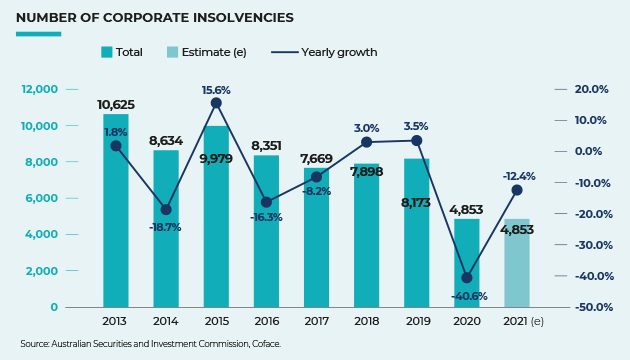

Australia
Synthesis
major macro economic indicators
| 2020 | 2021 | 2022 (e) | 2023 (f) | |
|---|---|---|---|---|
| GDP growth (%) | -2.2 | 4.9 | 3.7 | 2.4 |
| Inflation (yearly average, %) | 0.8 | 2.9 | 6.6 | 6.1 |
| Budget balance (% GDP) | -6.6 | -1.6 | -1.5 | -1.8 |
| Current account balance (% GDP) | 2.4 | 3.1 | 1.8 | 0.4 |
| Public debt (% GDP) | 57.2 | 58.4 | 56.7 | 58.6 |
(e): Estimate (f): Forecast *Fiscal year 2023: July 2023 - June 2024
STRENGTHS
- Geographic proximity to dynamic Asian economies, member of RCEP
- Richly endowed with mineral resources
- Moderate levels of public debt
- High tourism potential
WEAKNESSES
- Exposed to commodity price volatility (specifically iron ore, coal and LNG)
- Economy remains dependent on Chinese demand
- Substantial household debt (192% of gross disposable income)
- Shortage of infrastructure due to the country’s vast territory
- Vulnerable to climate change (bushfires and droughts)
- Disparity between federal states
Risk assessment
Economic growth slowed by inflation and monetary tightening
In 2022, Australian economic activity continued to benefit from strong post-pandemic recovery and favourable terms of trade amid high global commodity prices. Labour market tensions reflect the strength of the economic rebound and the unemployment rate is at a 50-year low. The unemployment rate fell to 3.4% of the labour force in November 2022, leaving the economy facing significant labour and skills shortages. However, wage growth has remained moderate (3.1% year-on-year in Q3 2022), thereby limiting the risks of a wage-price spiral.
While the job market will remain tight in 2023 (average unemployment rate at 4% of the labour force), Australian economic growth is expected to slow. Its main driver, private consumption (53% of GDP), will be dented by the durably high level of inflation, which is causing a decline in real disposable household income, as well as by a sharp increase in mortgage rates. While Australian households have one of the highest levels of debt to disposable income among developed economies (192%), some households may face pressure from rising debt service costs. The Reserve Bank of Australia (RBA) estimates that debt service could rise to 9.25% of household disposable income by the end of 2023, up from 7% in 2021. While higher mortgage rates will impact consumption, they are not expected to pose a risk to financial stability due to prudent lending standards and high bank and household reserves. Like consumption, inflation and monetary tightening will dampen private investment. Public investment should remain relatively resilient, driven by government support for green energy initiatives and transport infrastructure development. Last, net exports will contribute positively to GDP growth. Despite the slowdown in export growth caused by the gloomy economic outlook in Western trading partners and the weakness in China's real estate sector that may weigh on iron ore prices, net exports will be supported by China's reopening and a lower import bill.
Despite persistently high energy costs and a strong labour market, inflation will fall in 2023 after being held back by lower global oil prices and weaker domestic demand. High inflation already prompted the RBA to add 300 basis points to the Official Cash Rate (OCR) over the course of 2022, bringing it to 3.6% in March 2023.
Fiscal consolidation and a comfortable external position
In the 2021-2022 fiscal year, Australia embarked on a path of fiscal consolidation and significantly reduced its government deficit, benefiting from the withdrawal of post-pandemic stimulus measures and windfall revenues related to the strength of the economy. However, the end of the tax revenue "overperformance" slowed the pace of fiscal consolidation in the 2022-2023 fiscal year and the modified federal budget that was presented in October 2022 indicated a stable federal deficit of around 1.5% of GDP. This will ultimately depend on commodity export price trends and the extent to which funds are allocated to cost of living relief and climate change measures, which were two election promises of the recently elected Labour government. While rising debt servicing is expected to push up spending in the 2023-2024 financial year, tax reforms, in particular the downward adjustment of the income tax cut due to come into effect in July 2024, will partly offset this. This gradual fiscal consolidation is therefore expected to stabilise the government debt ratio over the medium term. In addition, the share of Australian public debt held by non-residents fell to 45% at the end of the second quarter of 2022 and has been falling since 2020.
Australia's current account has turned positive since 2019, driven by an expanding trade surplus and fuelled by strong growth in commodity exports. Australia's current account surplus will narrow but subsist in 2023, on back of durably strong iron, coal and liquefied natural gas exports. The comfortable trade surplus (4.2% of GDP) will offset growth in the services deficit (0.9% of GDP) and the primary income deficit (2.8% of GDP), linked respectively to the end of travel restrictions and increased overseas dividend payments by mining companies. As Australia seeks to reduce its dependence on China by diversifying the source of its foreign direct investment and free trade agreements, China’s resolve to stabilise relations with certain Western powers will lead it to partially reverse punitive trade measures imposed on Australian coal and agricultural products in 2020.
Political stability and the quest for independence from China
The May 2022 federal elections saw the centre-left Labour Party return to power after nine years in opposition, gaining a slim majority in the House of Representatives (the lower house of Parliament). The party won 77 out of 151 seats (up from 68 in the previous federal election in 2019), leaving 58 seats with the centre-right Liberal-National coalition previously in power. The weak opposition and basic support from smaller parties and independents, particularly in the Senate where Labour does not have a majority, will facilitate the party's policy-making. The government will focus on extending social welfare programmes, implementing climate change mitigation policies, addressing the issues of establishing an Australian Republic and including the Indigenous Voice to Parliament by referendum.
Externally, Australia will reinforce ties with the United States and the United Kingdom through their tripartite AUKUS military alliance, which was unveiled on 15 September 2021. The security agreement aims to counter Chinese expansionism in the Indo-Pacific region and build on the informal military and diplomatic cooperation between the US, India, Japan and Australia (in QUAD), and add to Australia's deepening commitments to its Pacific island neighbours. The agreement reflects its concern to curb growth of China’s influence in the region and could strain relations with China in the future.
Last updated: June 2023
Payments
Payment methods include:
- cash: Personal cheques and bank cheques: used for domestic and international transactions;
- credit cards;
- electronic transactions: includes point-of-sale (POS) electronic transactions, as well as mobile apps, electronic funds transfer (EFR) and internet transactions;
- EFT electronic funds and SWIFT bank transfers: the most commonly used payment method for international transactions. The majority of banks are connected to the SWIFT electronic network;
- the Australian dollar (AUD) is now also part of the Continuous Linked Settlement System (CLS), an interbank transfer system for processing foreign exchange transactions simultaneously.
Debt collection
Amicable phase
Parties are encouraged to negotiate and take “genuine steps” to settle commercial disputes prior to commencing proceedings. Parties in the Federal Court and Federal Circuit Court must file a “genuine steps” statement. Examples of such steps include settlement negotiations and informal settlement conferences with the other party.
Legal proceedings
If the amicable phase fails, proceedings will commence. The New South Wales (NSW) Supreme Court has a special list for commercial disputes, where it will proactively manage them to ensure an efficient resolution. Similar lists also operate for commercial disputes in the Supreme Courts of Victoria (Vic), Western Australia (WA) and Queensland (Qld).
If a corporate debt is overdue, uncontested, and over AUD 2,000, the creditor may issue a creditor’s statutory demand for payment of debt demanding payment within 21 days. Unless payment or an application to set it aside is made to the Court in this time, the company is presumed insolvent. The creditor may lodge a petition for winding-up of the debtor’s company. The presumption of insolvency lasts for three months following service of the statutory demand. For individuals, the process is similar, but proceedings are required to be commenced in the Fed Circuit Court or Fed Court.
In NSW, in debt recovery proceedings, a statement of claim must be personally served on the debtor, who must then pay the debt, or file and serve a defence on the creditor within 28 days (NSW), failing which default judgment may be entered against the debtor. There are different time frames for different states. If the debtor does not pay the debt and files a defence, orders will be made by the court to prepare the matter for hearing including discovery and the preparation and exchange of evidence that will be relied upon at the hearing.
During this phase, the parties may request and exchange particulars of the claim or defence made by the other party in the form of documents referred to in the claim or defence (e.g. copies of the relevant unpaid invoices and statements of account). If discovery is ordered, the parties will be required to exchange all documents that are relevant to their case. Otherwise, all documents which the parties wish to rely upon at the hearing must be included in their evidence. Before handing down judgment, the court will hold an adversarial hearing in which the witnesses of each party may be cross-examined by the other parties’ lawyers. Typically, straightforward claims may be completed within four to six months but disputed claims may last more than a year.
If a party is not satisfied with the judgment awarded by the court, it may appeal the decision. Appeals lodged against Supreme Court decisions are heard by the Court of Appeal in that state/territory. Any further appeal thereafter is heard by the High Court of Australia. The party seeking to appeal must seek leave and persuade the Court in a preliminary hearing that there is a special basis for the appeal, as the High Court will only re-examine cases of clear legal merit.
Local Courts or Magistrates Courts (depending on the state/territory) hear minor disputes involving amounts up to a maximum of AUD 50,000 Tasmania (Tas), AUD 75,000 Western Australia (WA), AUD 100,000 (NSW, Vic, South Australia (SA)), AUD 150,000 (Qld) or AUD 250,000 (Australian Capital Territory (ACT), Northern Territory (NT)). Beyond these thresholds, disputes involving claims up to AUD 750,000 in NSW, WA, SA or Qld are heard either by the County Court or District Court. There is no County Court or District Court in Tas, NT or ACT. Claims greater than AUD 750,000 in NSW, Qld, SA, and WA are heard by the Supreme Court of each State. The Victorian County Court and Supreme Court have an unlimited jurisdiction. In the other states and territories, the Supreme Court hears claims greater than: AUD 250,000 in the NT; AUD 250,000 in ACT; and AUD 50,000 in Tas.
Enforcement of a legal decision
A judgment is enforceable as soon as it is entered by the court. The plaintiff has up to fifteen years following the entry of judgment to pursue enforcement of an Australian judgment through Examination Notices, Garnishee Orders or Writs of Execution. Examination Notices force the debtor to provide information on its financial situation and assets, helping to establish a recovery strategy. The Garnishee allows the creditor to recover its debt (with interest and costs) directly from the debtor’s bank account or salary as well as from the debtor’s debtors,. Finally, the Writ orders a sheriff to seize and sell the debtor’s property in payment of the debt (together with interest and costs) owing to the creditor. As for foreign awards, enforcement in Australia is governed by statutory regimes (Pt 6 of the Service and Execution of Process Act 1992 (Cth) for judgments given in Australia and Foreign Judgments Act 1992 (Cth) for judgments given outside Australia) and common law principles. Recognition depends on whether a reciprocal recognition and enforcement agreement exists between Australia and the issuing country.
Insolvency procedures
Administration: a debtor company can be placed into administration by its directors, or by creditors that are owed money. The administrator will take full control of the company, and investigate and report to creditors as to the company’s business, property, affairs, and financial circumstances. There are three options available to creditors: end the administration and return the company to the director(s); approve a deed of company arrangement through which the company will pay all or part of its debts; or wind up the company.
Receivership: a receiver is appointed by a secured creditor who holds security or a charge over some or all of the company’s assets to collect the company’s assets to repay the debt owed to the secured creditor. If the process fails, a liquidation procedure may be initiated.
Liquidation: creditors or a court may wind up a company, and appoint a liquidator who collects, protects, and realises the company’s assets into cash, keep the creditors informed about the company’s affairs and distribute any proceeds of sale of company assets. Upon completion of the liquidation, the company is then deregistered.
Bankruptcy: creditors who have a judgment debt in excess of $5,000 can serve the debtor with a bankruptcy notice. The debtor must pay the debt or apply to set aside the bankruptcy notice within 21 days of service, otherwise the debtor will be presumed insolvent. The creditor can apply to the Federal Circuit Court to bankrupt and appoint a bankruptcy trustee to the debtor’s estate. The trustee collects, protects and realises the debtor’s assets into cash, keeps the creditors informed about the debtor’s affairs and distributes any proceeds of sale of the debtor’s assets. Generally, bankruptcy lasts for three years, but can be extended if the debtor does not co-operate with the trustee.








